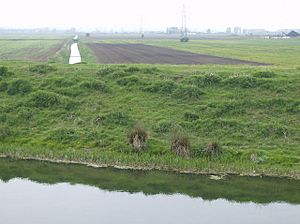Gilbert Heathcote's tunnel facts for kids
The Gilbert Heathcote's tunnel was an amazing engineering project from the 1630s. It was one of the first modern attempts to drain a huge, marshy area called The Fens in Lincolnshire, England. This tunnel helped move water away from the land, making it useful for farming. After World War II, newer, more powerful machines took over the job, so the tunnel was no longer needed and was finally removed in 1991.
Contents
What Was Gilbert Heathcote's Tunnel?
This special tunnel was designed to move water using only gravity. It collected water from areas like Bourne South Fen, Thurlby Fen, and Northorpe Fen. The water then flowed into a channel called the Counter Drain, and from there, it went to Deeping Fen.
Why Was a Tunnel Needed?
A tunnel was important because it had to go under the River Glen. The River Glen was (and still is) built up with high banks, making its water level about 3 meters (almost 10 feet) higher than the land around it and the Counter Drain. So, the tunnel allowed water to pass underneath this higher river. Further downstream, the Counter Drain later used wind-powered machines to pump water even further. When the tunnel was first built, Deeping Fen was still mostly flooded.
How Drainage Management Changed
For a long time, the drainage of these areas was managed by people called "adventurers." These were individuals or groups who invested in land drainage projects, hoping to make a profit from the newly usable land.
The Rise of Steam Power
In 1871, a new group called the Bourne South Fen Drainage District was created. They took over the important job of managing the drainage. Starting in 1872, powerful steam engines were brought in. These engines helped push the water through the tunnel more effectively, making the drainage system much better.
Where Was the Tunnel Located?
The tunnel was located about 500 meters (about a third of a mile) upstream from where the River Glen meets the Bourne Eau. The closest village to the tunnel's location is Tongue End. Even today, the road that runs alongside the original drain leading to where the tunnel once was is still called Tunnel Bank. This name reminds us of the important engineering feat that once existed there.
Who Was Gilbert Heathcote?
The tunnel is named after Gilbert Heathcote. He was likely the father of Sir Gilbert Heathcote, 1st Baronet, who was a very important person in his time. This family was also an ancestor of the first Baron Aveland. The Heathcote family later inherited Grimsthorpe Castle, which is nearby. They must have owned land and had strong connections to this area to be associated with the title of Aveland.
Modern Drainage Efforts
Today, the area that the tunnel once helped drain is now managed by the Welland and Deepings Internal Drainage Board. These boards are responsible for managing water levels and drainage in specific areas, ensuring that the land remains usable and protected from flooding.


